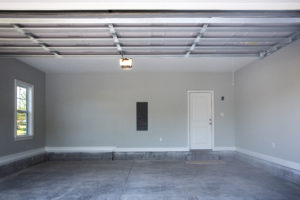Painting the Garage Isn’t Hard But There Are Some Tricks You Should Know

Garages are one of the most useful – and used – rooms in the house. They store our vehicles, lawn and sports equipment and sometimes even act as a second attic. But they’re also the least likely to be painted. That’s too bad because, not only does painting a garage make it look nicer, it can also protect the walls from wear and tear.
What Makes Painting a Garage Different?
Painting garages is like painting any other room – you prep, tape and drape, and paint. But garages have some extra considerations.
They’re prone to mildew.
Garages are exposed to water every time you drive in a rained-on car or put up a wet lawn mower. You may think, well, that’s just the floor – no big deal. But walls absorb dampness, so if yours aren’t protected, they can mold. So, look for paint that provides mildew resistance, like paints you would use in a bathroom.
They’re exposed to temperature fluctuations.
Since garages aren’t climate controlled, they’re also exposed to extreme temperature fluctuations. While there’s no paint that has a built-in fix for that, you can consider switching from latex to oil-based paint. While you wouldn’t use this inside your house because of the high VOCs, long dry time and yucky cleanup, you might look past these things when painting a garage.
That’s because you can open the garage door to ventilate and offset the VOCs while the paint dries. And the longer dry time is less of an issue because this is a relatively low-traffic room (no pun intended). The tradeoff is that you get a paint that dries to a hard, protective shell that resists scuffs and is more durable, especially in a room where the temps vary.
If oil paint is off the table, then look at interior latex paints. If you’re painting relatively clean drywall or plaster, you can use latex with built-in primer. If you’re painting dirty walls or walls made of concrete or cinder block, start with high-quality primer. This will help cover stains and will create a smooth surface for the paint to adhere too, especially important in porous materials like concrete and cinder block.
What Kind of Paint Should I Buy?
This is a case where buying more expensive paint is worth it. That’s because higher-quality paints have more solids in the mix, meaning a more durable, long-lasting finish. It will also save you money because, especially if you prime first, you’re likely to need only one coat of paint.
Speaking of finishes, when painting a garage, steer away from matte and high gloss. These both come with built-in issues that make them a not-so-good fit for garages. (Matte is the least durable/cleanable finish and high gloss reflects light, showing every imperfection in the walls.) Instead, focus on the midrange: eggshell, satin or semi-gloss. Semi-gloss tends to be the most durable, but only use it if you can create a perfect paint surface. Otherwise, like high gloss, you’ll see every ding.
Our interior painters can give your garage a fresh new look – and help it stand up to whatever you throw its way. Let our color consultants help you pick the right color for your garage.
